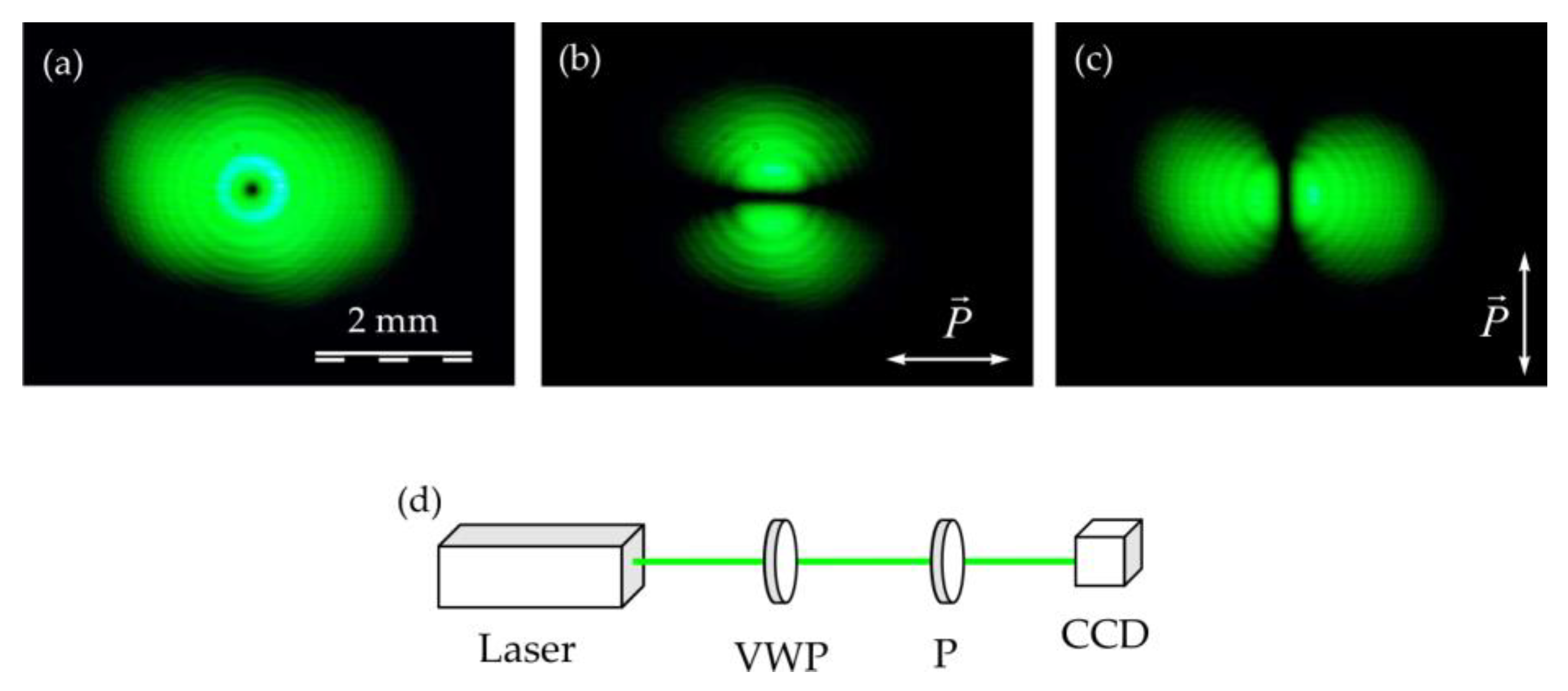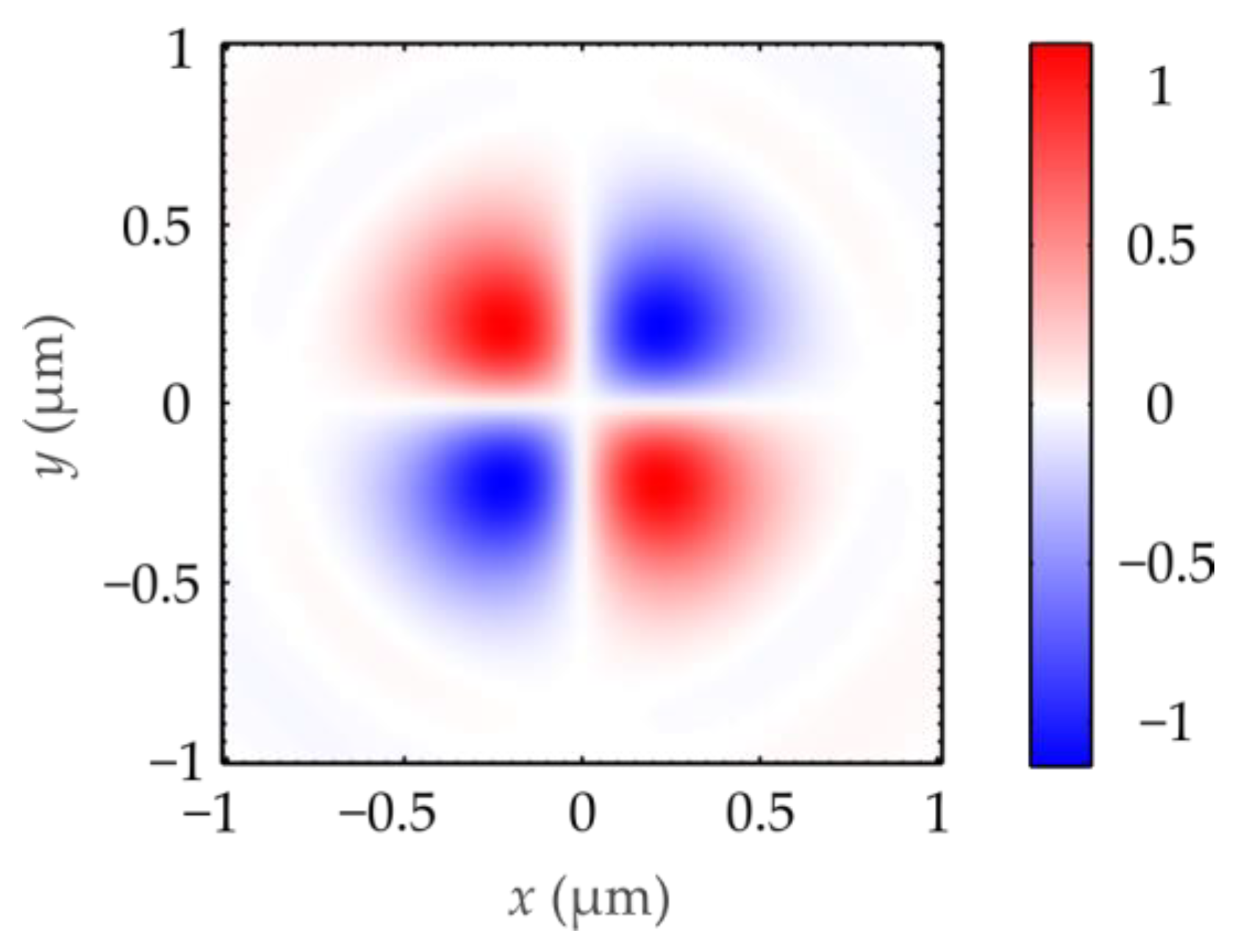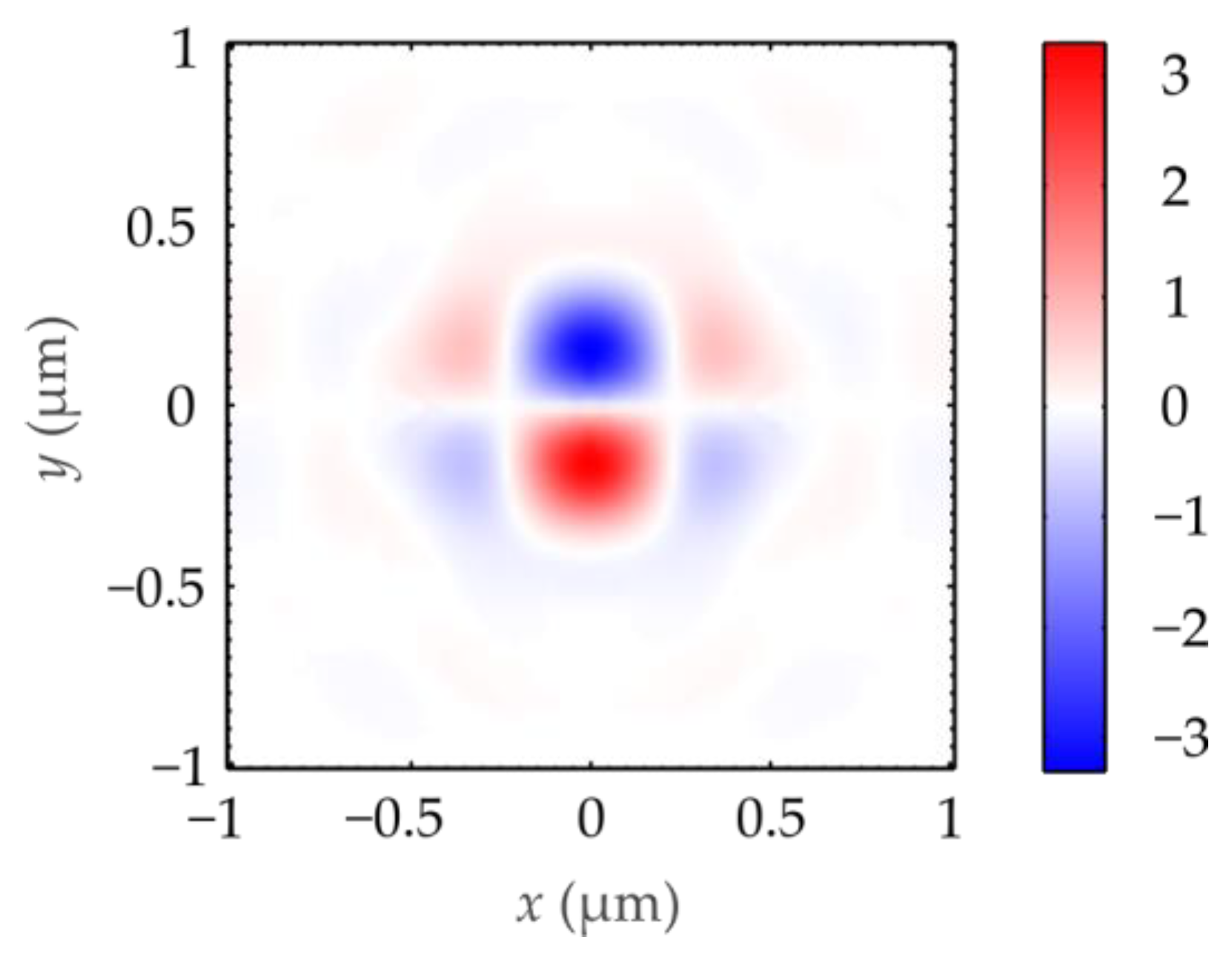Vector Beams with Only Transverse Intensity at Focus
Abstract
:1. Introduction
2. Methods
2.1. Numerical Simulation
2.2. Experimental Measurement
3. Results
3.1. Azimuthally Polarized Light
3.2. Beam with a V-Line of Polarization Singularity—Sector Azimuthal Polarization
3.3. Beam with Two V-Lines of Polarization Singularity
4. Discussion
5. Conclusions
Author Contributions
Funding
Institutional Review Board Statement
Informed Consent Statement
Data Availability Statement
Conflicts of Interest
References
- Zhan, Q. Cylindrical vector beams: From mathematical concepts to applications. Adv. Opt. Photonics 2009, 1, 1–57. [Google Scholar] [CrossRef]
- Hao, X.; Kuang, C.; Wang, T.; Liu, X. Phase encoding for sharper focus of the azimuthally polarized beam. Opt. Lett. 2010, 35, 3928–3930. [Google Scholar] [CrossRef]
- Yuan, G.H.; Wei, S.B.; Yuan, X.C. Nondiffracting transversally polarized beam. Opt. Lett. 2011, 36, 3479. [Google Scholar] [CrossRef]
- Kroychuk, M.K.; Shorokhov, A.S.; Yagudin, D.F.; Shilkin, D.A.; Smirnova, D.A.; Volkovskaya, I.; Shcherbakov, M.R.; Shvets, G.; Fedyanin, A.A. Enhanced Nonlinear Light Generation in Oligomers of Silicon Nanoparticles under Vector Beam Illumination. Nano Lett. 2020, 20, 3471–3477. [Google Scholar] [CrossRef]
- Kroychuk, M.K.; Yagudin, D.F.; Shorokhov, A.S.; Smirnova, D.A.; Volkovskaya, I.I.; Shcherbakov, M.R.; Shvets, G.; Kivshar, Y.S.; Fedyanin, A.A. Tailored Nonlinear Anisotropy in Mie-Resonant Dielectric Oligomers. Adv. Opt. Mater. 2019, 7, 1900447. [Google Scholar] [CrossRef]
- Sharif, V.; Pakarzadeh, H. High-performance surface plasmon resonance fiber sensor based on cylindrical vector modes. Sci. Rep. 2023, 13, 4563. [Google Scholar] [CrossRef]
- Khorsand, A.R.; Savoini, M.; Kirilyuk, A.; Kimel, A.V.; Tsukamoto, A.; Itoh, A.; Rasing, T. Role of Magnetic Circular Dichroism in All-Optical Magnetic Recording. Phys. Rev. Lett. 2012, 108, 127205. [Google Scholar] [CrossRef]
- Ignatyeva, D.O.; Davies, C.S.; Sylgacheva, D.A.; Tsukamoto, A.; Yoshikawa, H.; Kapralov, P.O.; Kirilyuk, A.; Belotelov, V.I.; Kimel, A.V. Plasmonic layer-selective all-optical switching of magnetization with nanometer resolution. Nat. Commun. 2019, 10, 4786. [Google Scholar] [CrossRef]
- Nie, Z.; Ding, W.; Li, D.; Zhang, X.; Wang, Y.; Song, Y. Spherical and sub-wavelength longitudinal magnetization generated by 4π tightly focusing radially polarized vortex beams. Opt. Express 2015, 23, 690. [Google Scholar] [CrossRef]
- Udhayakumar, M.; Prabakaran, K.; Rajesh, K.B.; Jaroszewicz, Z.; Belafhal, A. Generating sub wavelength pure longitudinal magnetization probe and chain using complex phase plate. Opt. Commun. 2018, 407, 275–279. [Google Scholar] [CrossRef]
- Wang, S.; Li, X.; Zhou, J.; Gu, M. Ultralong pure longitudinal magnetization needle induced by annular vortex binary optics. Opt. Lett. 2014, 39, 5022–5025. [Google Scholar] [CrossRef] [PubMed]
- Nie, Z.; Ning, Z.; Liu, X.; Zhang, Y.; Wang, H.; Cao, E.; Yan, W. Creating multiple ultra-long longitudinal magnetization textures by strongly focusing azimuthally polarized circular Airy vortex beams. Opt. Express 2023, 31, 19089–19101. [Google Scholar] [CrossRef] [PubMed]
- Gong, L.; Wang, L.; Zhu, Z.; Wang, X.; Zhao, H.; Gu, B. Generation and manipulation of super-resolution spherical magnetization chains. Appl. Opt. 2016, 55, 5783. [Google Scholar] [CrossRef]
- Nie, Z.; Ding, W.; Shi, G.; Li, D.; Zhang, X.; Wang, Y.; Song, Y. Achievement and steering of light-induced sub-wavelength longitudinal magnetization chain. Opt. Express 2015, 23, 21296. [Google Scholar] [CrossRef]
- Yan, W.; Nie, Z.; Zhang, X.; Wang, Y.; Song, Y. Magnetization shaping generated by tight focusing of azimuthally polarized vortex multi-Gaussian beam. Appl. Opt. 2017, 56, 1940–1946. [Google Scholar] [CrossRef]
- Yan, W.; Nie, Z.; Liu, X.; Lan, G.; Zhang, X.; Wang, Y.; Song, Y. Dynamic control of transverse magnetization spot arrays. Opt. Express 2018, 26, 16824. [Google Scholar] [CrossRef] [PubMed]
- Zand, M.; Miri, M.; Sadrara, M. Pure magnetic hotspots via hollow silicon nanoparticles illuminated by cylindrical vector beams. J. Appl. Phys. 2023, 133, 093101. [Google Scholar] [CrossRef]
- Miao, Y.; Wang, L.; Zhang, Q.; Sun, X.; Gao, X.; Wan, J.; Zhuang, S. Tight-focusing properties of propagable fractional-order vector vortex beams. J. Opt. Soc. Am. B 2023, 40, 1113. [Google Scholar] [CrossRef]
- Stafeev, S.S.; Nalimov, A.G.; Zaitsev, V.D.; Kotlyar, V.V. Tight focusing cylindrical vector beams with fractional order. J. Opt. Soc. Am. B 2021, 38, 1090. [Google Scholar] [CrossRef]
- Ma, C.; Song, T.; Chen, R.; Li, H.; Li, X. Shaping focal field by grafted polarization. Opt. Express 2023, 31, 8120. [Google Scholar] [CrossRef]
- Wang, J.; Dong, F.; Zhang, K.; Zhou, Y.; Song, Z.; Hu, H.; Xu, L.; Jiang, H.; Liang, G.; Zhang, Z.; et al. Generating a Superoscillation Three-Dimensional Hollow Spot by Polarization Manipulation. Phys. Rev. Appl. 2023, 19, 044069. [Google Scholar] [CrossRef]
- Kotlyar, V.V.; Stafeev, S.S.; Nalimov, A.G.; O’Faolain, L. Subwavelength grating-based spiral metalens for tight focusing of laser light. Appl. Phys. Lett. 2019, 114, 141107. [Google Scholar] [CrossRef]
- Richards, B.; Wolf, E. Electromagnetic Diffraction in Optical Systems. II. Structure of the Image Field in an Aplanatic System. Proc. R. Soc. Lond. Ser. A 1959, 253, 358–379. [Google Scholar] [CrossRef]
- Pereira, S.F.; van de Nes, A.S. Superresolution by means of polarisation.; phase and amplitude pupil masks. Opt. Commun. 2004, 234, 119–124. [Google Scholar] [CrossRef]
- Davidson, N.; Bokor, N. High-numerical-aperture focusing of radially polarized doughnut beams with a parabolic mirror and a flat diffractive lens. Opt. Lett. 2004, 29, 1318–1320. [Google Scholar] [CrossRef]
- Freund, I. Polarization singularity indices in Gaussian laser beams. Opt. Commun. 2002, 201, 251–270. [Google Scholar] [CrossRef]
- Khonina, S.N.; Volotovsky, S.G. Controlling the contribution of the electric field components to the focus of a high-aperture lens using binary phase structures. J. Opt. Soc. Am. A 2010, 27, 2188–2197. [Google Scholar] [CrossRef]
- Khonina, S.N. Simple phase optical elements for narrowing of a focal spot in high-numerical-aperture conditions. Opt. Eng. 2013, 52, 091711. [Google Scholar] [CrossRef]
- Stafeev, S.S.; Kotlyar, V.V.; Nalimov, A.G.; Kozlova, E.S. The Non-Vortex Inverse Propagation of Energy in a Tightly Focused High-Order Cylindrical Vector Beam. IEEE Photonics J. 2019, 11, 4500810. [Google Scholar] [CrossRef]
- Kotlyar, V.; Stafeev, S.; Zaitsev, V.; Kozlova, E. Spin-Orbital Conversion with the Tight Focus of an Axial Superposition of a High-Order Cylindrical Vector Beam and a Beam with Linear Polarization. Micromachines 2022, 13, 1112. [Google Scholar] [CrossRef]
- Nechayev, S.; Eismann, J.S.; Leuchs, G.; Banzer, P. Orbital-to-spin angular momentum conversion employing local helicity. Phys. Rev. B 2019, 99, 075155. [Google Scholar] [CrossRef]
- Stafeev, S.S.; Nalimov, A.G.; Kovalev, A.A.; Zaitsev, V.D.; Kotlyar, V.V. Circular Polarization near the Tight Focus of Linearly Polarized Light. Photonics 2022, 9, 196. [Google Scholar] [CrossRef]
- Shu, W.; Lin, C.; Wu, J.; Chen, S.; Ling, X.; Zhou, X.; Luo, H.; Wen, S. Three-dimensional spin Hall effect of light in tight focusing. Phys. Rev. A 2020, 101, 23819. [Google Scholar] [CrossRef]









Disclaimer/Publisher’s Note: The statements, opinions and data contained in all publications are solely those of the individual author(s) and contributor(s) and not of MDPI and/or the editor(s). MDPI and/or the editor(s) disclaim responsibility for any injury to people or property resulting from any ideas, methods, instructions or products referred to in the content. |
© 2023 by the authors. Licensee MDPI, Basel, Switzerland. This article is an open access article distributed under the terms and conditions of the Creative Commons Attribution (CC BY) license (https://creativecommons.org/licenses/by/4.0/).
Share and Cite
Stafeev, S.S.; Kazakov, N.N.; Zaitsev, V.D.; Poletayev, S.D.; Kotlyar, V.V. Vector Beams with Only Transverse Intensity at Focus. Appl. Sci. 2023, 13, 12519. https://doi.org/10.3390/app132212519
Stafeev SS, Kazakov NN, Zaitsev VD, Poletayev SD, Kotlyar VV. Vector Beams with Only Transverse Intensity at Focus. Applied Sciences. 2023; 13(22):12519. https://doi.org/10.3390/app132212519
Chicago/Turabian StyleStafeev, Sergey S., Nikita N. Kazakov, Vladislav D. Zaitsev, Sergey D. Poletayev, and Victor V. Kotlyar. 2023. "Vector Beams with Only Transverse Intensity at Focus" Applied Sciences 13, no. 22: 12519. https://doi.org/10.3390/app132212519
APA StyleStafeev, S. S., Kazakov, N. N., Zaitsev, V. D., Poletayev, S. D., & Kotlyar, V. V. (2023). Vector Beams with Only Transverse Intensity at Focus. Applied Sciences, 13(22), 12519. https://doi.org/10.3390/app132212519





